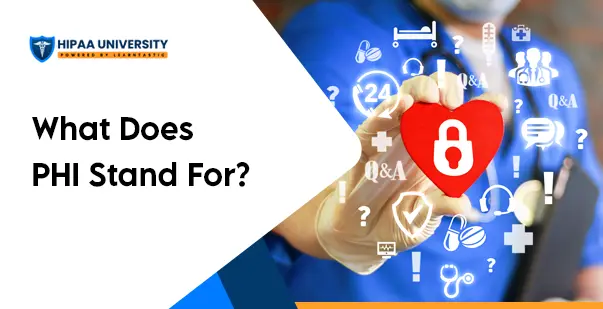What Does PHI Stand For?

August 7, 2024
Table of Contents:
- Introduction
- What does PHI stand for?
- What is PHI?
- Key components of PHI: The direct identifiers
- The Importance of HIPAA in Protecting PHI
- Who Uses PHI?
- What Is Not PHI?
- PHI and its various forms
- Why Does PHI Matter?
- Best Practices for Managing PHI
- Final Thoughts
Introduction
Personal health information is essential in the modern healthcare system when it comes to provide patients the best care while protecting their privacy. Keeping Personal Health Information secure and confidential has become an essential concern for healthcare organizations as increasing numbers of medical records are being digitally recorded. PHI is a fundamental component of healthcare. Understanding PHI medical abbreviation, regulations, uses, and protections is essential to maintaining compliance for your healthcare organization.
Here, we go into great depth about What does PHI stand for and how healthcare organizations can use it effectively to avoid imposing significant penalties.
What does PHI stand for?
PHI stands for Protected Health Information, and it refers to any information in a medical record that may be used to identify an individual. It is generated, used, or disclosed while providing a healthcare service, including a diagnosis or treatment. Protected health information breaches have impacted over 176 million patients in the United States from 2009 to 2020.
What is PHI?
PHI is an acronym for Protected Health Information, which includes personally identifiable information found in medical records, such as discussions about treatment between physicians and nurses.
PHI regulations were developed by the Health Information Technology for Economic and Clinical Health (HITECH) Act and the Health Insurance Portability and Accountability Act of 1996 (HIPAA). These rules impose restrictions on the sharing of patient data between organizations and provide accurate technical specifications for the storage of sensitive data.
“Protected health information” is the term used by the Health Insurance Portability and Accountability Act (HIPAA) to describe the categories of patient data that must comply with legal requirements. To be in compliance with the law, eHealth applications that gather, store, or exchange PHI must adhere to HIPAA compliance standards.
Key components of PHI: The direct identifiers
HIPAA uses identifiers to determine whether health information is regarded as PHI. Here are some of these identifiers:
- Names
- Addresses
- Dates that relates to the health or identity of an individual
- Telephone numbers
- Fax numbers
- Email addresses
- Social security numbers
- Medical record numbers
- Health insurance beneficiary numbers
- Certificate/license numbers
- Vehicle identifiers
- Health plan beneficiary numbers
- Device attributes or serial numbers
- Digital identifiers, such as website URLs and IP addresses
- Biometric elements, such as fingerprints, retinal, and voiceprints
- Photographs of a patient’s face
- Other identifying numbers or codes
- Genetic information
When these identifiers are generated or obtained by a covered entity, they are regarded as protected health information (PHI) since they serve to directly identify an individual. Any individual or organization that regularly manages PHI health data is considered a covered entity under HIPAA.
Health insurance companies and healthcare providers must handle the list of identifiers carefully as it was developed to guarantee that health data can be identified and traced back to an individual.
The Importance of HIPAA in Protecting PHI
The Health Insurance Portability and Accountability Act, or HIPAA, is essential to the protection of personal health information (PHI). HIPAA places severe restrictions on covered entities and business associates that handle PHI. It is a cornerstone of US healthcare privacy and security laws.
This covers any third-party organizations that manage PHI on behalf of covered entities, as well as healthcare clearinghouses, health plans, and providers. HIPAA contributes to ensuring PHI’s availability, confidentiality, and integrity by putting in place comprehensive policies and procedures, regularly assessing risks, and utilizing the right technological safeguards.
Under HIPAA, covered entities as well as business associates are required to follow a set of privacy rules that control the use and disclosure of PHI. Unless the patient approves or as required by law, these regulations restrict the use and disclosure of PHI to treatment, payment, and healthcare operations uses only.
Other safeguards include:
- Firewalls
- Antivirus Software
- Intrusion Detection System
- Regular Backups
Read more: What is considered PHI under HIPAA?
Why Does PHI Matter?
Healthcare providers deal with sensitive patient information such as birth dates, medical conditions, and insurance claims. When de-identified or anonymized, PHI is useful to clinical and scientific researchers in addition to patients and healthcare providers. Here are the following reasons why PHI is important:
- PHI is valuable personally identifiable information (PII) to cybercriminals, who may use it for ransomware, sell it on the dark web, or utilize it to steal identities.
- Healthcare providers are required to maintain the privacy of patient medical records, which makes protected health information important.
- Providers take specific measures to guarantee that PHI is secure at all times because most of the information is extremely personal.
- Healthcare professionals, health maintenance organizations (HMOs), and their patients all have a strong implicit trust in one another, and patients have a right to expect that healthcare organizations will appropriately secure their PHI.
- This protection applies throughout a patient’s experience and at any location where care is provided, including a doctor’s office, a hospital, a remote hospital, or a telemedicine visit.
- Individuals may also submit written requests under HIPAA to modify PHI that is kept by a covered entity.
Who Uses PHI?
To effectively carry out your duties, it is imperative that you are aware of all stakeholders involved in the use of PHI. The following various roles must also use PHI and comply with HIPAA rules.
Healthcare Providers
Healthcare providers are a diverse group of professionals, involving Nursing aides, Doctor, Nurses, Nurse practitioners, and Physician assistants.
It is essential to have a thorough understanding of PHI and HIPAA, regardless of your level of experience in the field. Whether it is looking up a patient’s name or looking through their medical records, it is imperative to protect every aspect covered by PHI.
Health Insurance Companies
Working with health insurance companies, which are regarded as HIPAA-covered entities, is a necessary component of a healthcare provider. These companies can be contacted about patient-related issues such as healthcare costs and insurance coverage. However, when sharing details, it is important to use caution and be aware of the specifics being provided.
Government Healthcare Programs
It might be required to have PHI-related conversations with government health insurance programs like Medicaid or Medicare if patients have enrolled in them. Programs for the health of veterans and members of the armed forces are additional examples of organizations covered by HIPAA.
Clearinghouses
Healthcare clearinghouses work together with insurance companies and healthcare providers to guarantee that medical claims are processed correctly and accurately. Verifying the accuracy of claims and transforming non-standard data into standard data that can be easily integrated into the payers’ system are the primary responsibilities. It is important to remember that these clearinghouses are not the same as the ones that are usually listed on bank statements.
What Is Not PHI?
It’s important to understand PHI and keep in mind that not all records kept in a healthcare facility are simply confidential. Here are some examples to consider:
- Education records
- Employee information
- Pay stubs
- Accounting records
Healthcare organizations are in charge of keeping various records, some of that may not be considered PHI if they are not related to specific patients. Managing any information with caution and assuming it falls under PHI is the best course of action in cases of uncertainty. If you are not sure about the category of certain information, speak with others to avoid accidentally disclosing confidential information and to gain a better understanding of what falls outside the scope of HIPAA.
PHI and its Various Forms
PHI can be found in various forms, including medical histories, test results, insurance information, and electronic health records.
- ePHI: One form of PHI is electronic protected health information, or ePHI, which is created, saved, transmitted, or received in electronic format.
- Documented PHI: PHI can also appear in a wide range of documents, forms, and communication channels, such as medical bills, insurance forms, and doctor’s notes, which are often handled by healthcare professionals.
Under HIPAA, it is important to distinguish between paper and electronic PHI records due to certain factors, such as the speed at which patients can request access to their data and disposal methods. The identifiers are essential in determining whether the information is PHI under HIPAA, ensuring that the data is used, shared, and protected appropriately.
Read More: Who Must Comply with HIPAA Rules and Regulations?
Best Practices for Managing PHI
When you manage PHI, it is essential to keep it safe. Here are few of the simple steps to follow:
- Know what is PHI: Understand what counts as PHI. This includes any health information that can identify a person. Knowing what to protect is the first step.
- Use strong passwords: Always use strong passwords for systems that store PHI. Change these passwords often to prevent unauthorized access.
- Encrypt your data: Ensure that PHI is encrypted. Encryption turns data into a secret code that can only be read with the key, preventing unauthorized access.
- Limit access: Limit access to PHI to those who require it for professional reasons. This lowers the possibility of information leaking.
- Train your team: Provide regular training to your team on handling PHI properly. This helps everyone stay aware of the best practices for keeping PHI safe.
- Update your systems: Keep your software and systems up to date to protect against viruses and hackers.
- Have a response plan: Be prepared for a PHI breach. Know what to do if PHI is lost or stolen, including notifying the right people and quickly fixing the issue.
- Use secure communication methods: When sharing PHI, use secure emails or systems to ensure the information does not go to the wrong person.
- Regular checks: Regularly audit how PHI is handled in your organization to identify any weaknesses before they become significant problems.
- Stay informed: Keep up to date with new laws and tips about PHI. Staying informed helps you maintain PHI security.
Final Thoughts
Understanding what does PHI stands for and how to safeguard it can help you avoid significant penalties for compliance violations. Staying current with patient privacy laws and compliance regulations in the healthcare sector can be challenging, but you don’t have to do it alone.
Healthcare organizations, experts, and patients can collaborate to ensure that PHI is used, shared, and protected appropriately by remaining informed and implementing best practices. Maintaining trust and securing the future of healthcare innovation in the ever-changing world of the healthcare industry requires being proactive and cautious when it comes to protecting PHI.





